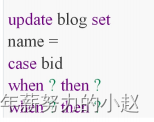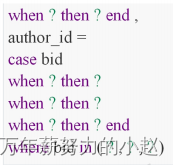我们在项目中会有一些批量操作的场景,比如导入文件批量处理数据的情况(批量新增商户、批量修改商户信息),当数据量非常大,比如超过几万条的时候,在Java代码中循环发送SQL到数据库执行肯定是不现实的,因为这个意味着要跟数据库创建几万次会话。即使在同一个连接中,也有重复编译和执行SQL的开销。
例如循环插入10000条(大约耗时3秒钟)∶
/**
* 循环批量插入
*/
@Test
public void testInsertOneByOne() {
long start = System.currentTimeMillis();
int count = 12000;
for (int i=2000; i< count; i++) {
Blog blog = new Blog();
blog.setBid(i);
blog.setName("name"+i);
blog.setAuthorId(i);
mapper.insertBlog(blog);
}
session.commit();
session.close();
long end = System.currentTimeMillis();
System.out.println("循环批量插入"+count+"条,耗时:" + (end -start )+"毫秒");
}
在MyBatis里面是支持批量的操作的,包括批量的插入、更新、删除。我们可以直接传入一个 List. Set、Map或者数组,配合动态SQL的标签,MyBatis 会自动帮我们生成语法正确的SQL语句。
批量插入
批量插入的语法是这样的,只要在values后面增加插入的值就可以了。

在Mapper 文件里面,我们使用foreach标签拼接values 部分的语句:
<!-- foreach 动态SQL 批量插入 -->
<insert id="insertBlogList" parameterType="java.util.List">
insert into blog (bid, name, author_id)
values
<foreach collection="list" item="blogs" index="index" separator=",">
( #{blogs.bid},#{blogs.name},#{blogs.authorId} )
</foreach>
</insert>
Java代码里面,直接传入一个List类型的参数。
/**
* MyBatis 动态SQL批量插入
* @throws IOException
*/
@Test
public void testInsert() throws IOException {
long start = System.currentTimeMillis();
int count = 12000;
List<Blog> list = new ArrayList<Blog>();
for (int i=2000; i< count; i++) {
Blog blog = new Blog();
blog.setBid(i);
blog.setName("name"+i);
blog.setAuthorId(i);
list.add(blog);
}
mapper.insertBlogList(list);
session.commit();
session.close();
long end = System.currentTimeMillis();
System.out.println("动态SQL批量插入"+count+"条,耗时:" + (end -start )+"毫秒");
}
插入一万条大约耗时1秒钟。
可以看到,动态SQL批量插入效率要比循环发送SQL执行要高得多。
最关键的地方就在于减少了跟数据库交互的次数,并且避免了开启和结束事务的时间消耗。
批量更新
批量更新的语法是这样的,通过case when,来匹配 id相关的字段值。


所以在Mapper文件里面最关键的就是case when和where 的配置。需要注意一下open属性和separator属性。
<!-- foreach 动态SQL 批量更新-->
<update id="updateBlogList">
update blog set
name =
<foreach collection="list" item="blogs" index="index" separator=" " open="case bid" close="end">
when #{blogs.bid} then #{blogs.name}
</foreach>
,author_id =
<foreach collection="list" item="blogs" index="index" separator=" " open="case bid" close="end">
when #{blogs.bid} then #{blogs.authorId}
</foreach>
where bid in
<foreach collection="list" item="item" open="(" separator="," close=")">
#{item.bid,jdbcType=INTEGER}
</foreach>
</update>
/**
* MyBatis 动态SQL批量更新
* @throws IOException
*/
@Test
public void updateBlogList() throws IOException {
long start = System.currentTimeMillis();
int count = 12000;
List<Blog> list = new ArrayList<Blog>();
for (int i=2000; i< count; i++) {
Blog blog = new Blog();
blog.setBid(i);
blog.setName("modified name"+i);
blog.setAuthorId(i);
list.add(blog);
}
mapper.updateBlogList(list);
session.commit();
session.close();
long end = System.currentTimeMillis();
System.out.println("批量更新"+count+"条,耗时:" + (end -start )+"毫秒");
}
批量删除
批量删除也是类似的。
<!-- foreach 动态SQL 批量删除 -->
<delete id="deleteByList" parameterType="java.util.List">
delete from blog where bid in
<foreach collection="list" item="item" open="(" separator="," close=")">
#{item.bid,jdbcType=INTEGER}
</foreach>
</delete>
/**
* 动态SQL批量删除
* @throws IOException
*/
@Test
public void testDelete() throws IOException {
SqlSession session = sqlSessionFactory.openSession();
try {
BlogMapper mapper = session.getMapper(BlogMapper.class);
List<Blog> list = new ArrayList<Blog>();
Blog blog1 = new Blog();
blog1.setBid(666);
list.add(blog1);
Blog blog2 = new Blog();
blog2.setBid(777);
list.add(blog2);
mapper.deleteByList(list);
} finally {
session.close();
}
}
缺点
当然 MyBatis 的动态标签的批量操作也是存在一定的缺点的,比如数据量特别大的时候,拼接出来的SQL语句过大。
MySQL的服务端对于接收的数据包有大小限制,max_allowed_packet默认是4M,需要修改默认配置或者手动地控制条数,才可以解决这个问题。
Caused by: com.mysql.jdbc.PacketTooBigException: Packet for query is too large(7188967>4194304).Youcan change this value on the server by setting the max_allowed_packet’ variable.
解决缺点
在我们的全局配置文件中,可以配置默认的Executor的类型(默认是SIMPLE)。其中有一种 BatchExecutor。


一共有3种

思考:三种类型的区别?(通过doUpdate()方法对比)
1)SimpleExecutor:每执行一次update或select,就开启一个 Statement对象,用完立刻关闭Statement对象。
2)ReuseExecutor:执行update或select,以sql作为key查找 Statement对象,存在就使用,不存在就创建,用完后,不关闭Statement对象,而是放置于Map内,供下一次使用。简言之,就是重复使用Statement对象。
3)BatchExecutor:执行update (没有select,JDBC批处理不支持select),将所有sql都添加到批处理中(addBatch()),等待统一执行(executeBatch()),它缓存了多个 Statement对象,每个Statement对象都是addBatch()完毕后,等待逐一执行executeBatch()批处理。与JDBC批处理相同。
executeUpdate()是一个语句访问一次数据库,executeBatch()是一批语句访问一次数据库(具体一批发送多少条SQL跟服务端的max_allowed_packet有关)。
BatchExecutor底层是对JDBC ps.addBatch()和ps. executeBatch()的封装。























 3万+
3万+











 被折叠的 条评论
为什么被折叠?
被折叠的 条评论
为什么被折叠?










